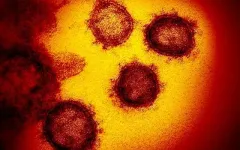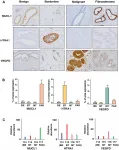(Press-News.org) URBANA, Ill. - Opioid use has dramatically increased in the 21st century, especially among young adults. A new study from the University of Illinois provides insights on usage patterns among Illinois high school students to help inform prevention and treatment strategies.
"The societal and personal costs of opioid misuse are massive. There's been a lot of focus on trying to understand how to combat the current epidemic. But we also need to make sure we have good data in order to know how we should apply our efforts," says Allen Barton, assistant professor in the Department of Human Development and Family Studies at U of I and lead author on the study.
The researchers based their study on information from the 2018 Illinois Youth Survey (IYS), which measures risk behaviors among high school students.
Over 230,000 students across Illinois typically participate in the biannual survey, says Doug Smith, professor of social work and director of the Center for Prevention Research and Development at U of I. Smith is co-author on the opioid study and principal investigator for the IYS.
The study focused on 18-to 19-year-olds, the beginning of a developmental stage when opioid use vulnerability is highest, Barton says.
Among the more than 26,000 respondents in this age group, 5.6% (1,468 youth) indicated they had used prescription pain medication in the past year without a prescription or differently than intended; that is, non-medical use of prescription opioids.
"Another 2.6% (682 youth) reported they had used prescription painkillers to get high. This addresses motive of use, which is an important part of understanding the issue," Barton says.
Finally, 0.4% of the sample (105 youth) reported they had used heroin in the past year. Heroin is another form of opioid that is not in the form of prescription medication, Barton notes.
The researchers found clear differences in characteristics of opioid users versus non-users.
"The individuals engaging in opioid use are also engaging in heightened levels of other forms of substance misuse, primarily alcohol and cannabis. They have more mental health concerns and higher suicide intent. And those who are using opioids report much lower grades and much higher levels of being victims of bullying," Barton says.
As opioid use is closely linked with other forms of substance misuse, counselors and medical practitioners should treat it as part of a pattern, Smith states. "This contradicts the typical image of a non-substance-using youth who one day decides to use opioids and then gets progressively addicted. That doesn't typically happen. These kids are already using other substances, often at levels indicative of problematic use. It seems more like a progression of general substance use than specific opioid usage," he notes.
The researchers also analyzed the data to look for profiles among the subset of youth using opioids.
"Our findings indicated three main profiles of individuals reporting opioid use. You have one group, comprising slightly more than half of this subsample, that's using opioids, but not specifically to get high. You have another group of individuals reporting a clear motive of use to get high. And a third, small group that's just using heroin," Barton notes.
While there were many similarities among the three groups, individuals who reported using opioids to get high also reported much more problematic substance abuse overall, as well as higher suicide risk compared to people who are engaged in non-medical use of prescription opioids without such motive, Smith adds.
The researchers say their study shows opioid use is a complex issue which needs tailored approaches to treatment and prevention.
"In order to address opioid use at this developmental stage, which is a transition to adulthood, we need to realize it is indicative of a broader pattern of factors related to other substance use and mental health issues that require attention. A one-step approach to just address the opioid use may not be sufficient," Barton states.
"The good news in this data is that opioid use rates are very low for this demographic across the state. However, for a subset of youth who do use, it appears to be making a difficult situation all the more challenging."
Barton and Smith say the correlation with other forms of substance misuse can help identify opioid use at an early stage.
"For any youth who is getting treatment for another substance, we need to be screening for whether they're using opioids, and we need to have a prevention program within a treatment program," Smith says.
INFORMATION:
The IYS is administered every other year to schools across Illinois. Survey reports are available at the Illinois Youth Survey website. Schools can also register online for participation.
The Department of Human Development and Family Studies is in the College of Agricultural, Consumer and Environmental Sciences, University of Illinois.
The paper, "Opioid use at the transition to emerging adulthood: A latent class analysis of non-medical use of prescription opioids and heroin use," is published in Addictive Behaviors. [DOI: 10.1016/j.addbeh.2020.106757]
Authors include Allen Barton, Crystal Reinhart, Corey Campbell, and Doug Smith.
Support for the development of this article was provided by the Illinois Department of Human Services (#43CZZ03292; PI: Smith). The views expressed by the authors are their own, however, and do not reflect official positions of the State of Illinois.
Using molecular dating tools and epidemiological simulations, researchers at University of California San Diego School of Medicine, with colleagues at the University of Arizona and Illumina, Inc., estimate that the SARS-CoV-2 virus was likely circulating undetected for at most two months before the first human cases of COVID-19 were described in Wuhan, China in late-December 2019.
Writing in the March 18, 2021 online issue of Science, they also note that their simulations suggest that the mutating virus dies out naturally more than three-quarters of the time without causing an epidemic.
"Our study was designed to answer the question of how long could SARS-CoV-2 have circulated in China before it was discovered," said senior author Joel O. Wertheim, PhD, associate professor in the ...
PROVIDENCE, R.I. [Brown University] -- In 2018, physicists showed that something interesting happens when two sheets of the nanomaterial graphene are placed on top of each other. When one layer is rotated to a "magic angle" of around 1.1 degrees with respect to the other, the system becomes a superconductor -- meaning it conducts electricity with zero resistance. Even more exciting, there was evidence that it was an unconventional form of superconductivity -- a type that can happen at temperatures well above absolute zero, where most superconducting materials function.
Since the initial discovery, researchers have been working to understand this exotic state of matter. Now, a research ...
Researchers at Baylor College of Medicine and the Jan and Dan Duncan Neurological Research Institute at Texas Children's Hospital (NRI) have identified and characterized two regions of DNA required for the proper expression of Mecp2/MECP2 in mice and humans.
These findings, published in Genes & Development, are helping to shed light on the function of these DNA regions and how they could be potential targets for diagnostic and therapeutic interventions for intellectual disabilities such as Rett Syndrome and MECP2 Duplication Syndrome.
Both of these intellectual disabilities are examples of the importance of precise MeCP2 protein levels for proper brain function. A decrease in this protein leads to Rett Syndrome, while an increase in this protein ...
A set of surveys fielded last year found that a large majority of U.S. adults support COVID-19 mitigation measures, including indoor mask wearing, social distancing, and contact tracing, with significant differences across certain groups. The surveys, which followed the same people in April, July, and November 2020, were conducted by a team of researchers at the Johns Hopkins Bloomberg School of Public Health with colleagues at the SNF Agora Institute at Johns Hopkins University.
Overall public support for COVID-19 mitigation measures was strongest in April 2020 with support remaining high in July and November. The November survey found that 79 percent of U.S. adults supported mask wearing, 78 percent supported social distancing, ...
While the drug tamoxifen reduces the risk of developing breast cancer and prevents recurrence, the side-effects cause many women to discontinue their treatment. A study involving researchers at Karolinska Institutet in Stockholm has now found that a much lower dose than the standard produces a good effect with fewer adverse reactions in women who have yet to enter the menopause. The study, which has been published in the Journal of Clinical Oncology, can play a significant role in the treatment of cancer.
The anti-hormone drug tamoxifen has been used for over 40 years to reduce the risk of relapse in women who have been treated for hormone-related ...
Oncotarget published "Quantitative proteome profiling stratifies fibroepithelial lesions of the breast" which reported that the current grading system remains unreliable in differentiating these tumors due to histological heterogeneity and lack of appropriate markers to monitor the sudden and unpredictable malignant transformation of PTs.
The high- throughput quantitative proteomic analysis suggested that FAD and PTs form distinct clusters away from borderline and malignant though there exist marked differences between them.
Interestingly, over-expression of extracellular matrices related proteins and epithelial-mesenchymal transition markers in borderline PTs led these authors to hypothesize a model of deposition and degradation leading to ECM remodeling and EMT acquisition ...
DALLAS, March 17, 2021 -- Immediate angiography, rather than the standard computed tomography (CT scan), reduced stroke treatment time and was linked to improved recovery, according to late-breaking science presented today at the American Stroke Association's International Stroke Conference 2021. The virtual meeting is March 17-19, 2021 and is a world premier meeting for researchers and clinicians dedicated to the science of stroke and brain health.
Standard emergency department treatment for stroke patients involves a CT scan, which uses X-rays to pinpoint the presence and location of a blood clot. Angiography is an advanced X-ray imaging method that uses a catheter, or thin tube, inserted into the blood vessel to find the location and size ...
DALLAS, March 17, 2021 -- Stroke patients treated via a mobile stroke unit (MSU) received clot-busting medications faster and more often - and recovered significantly better than patients who receive regular emergency care by standard ambulance, according to late-breaking science presented today at the American Stroke Association's International Stroke Conference 2021. The virtual meeting is March 17-19, 2021 and is a world premier meeting for researchers and clinicians dedicated to the science of stroke and brain health.
"Our goal in this study was to treat patients on the mobile stroke unit within an hour of the onset of their stroke ...
CHARLOTTESVILLE, Va. - Progress in the field of integrated circuits is measured by matching, exceeding, or falling behind the rate set forth by Gordon Moore, former CEO and co-founder of Intel, who said the number of electronic components, or transistors, per integrated circuit would double every year. That was more than 50 years ago, and surprisingly his prediction, now called Moore's Law, came true.
In recent years, it was thought that the pace had slowed; one of the biggest challenges of putting more circuits and power on a smaller chip is managing heat.
A multidisciplinary group that includes Patrick E. Hopkins, a professor in the University of Virginia's Department of Mechanical and Aerospace ...
In 1958, a magnitude 7.8 earthquake triggered a rockslide into Southeast Alaska's Lituya Bay, creating a tsunami that ran 1,700 feet up a mountainside before racing out to sea.
Researchers now think the region's widespread loss of glacier ice helped set the stage for the quake.
In a recently published research article, scientists with the University of Alaska Fairbanks Geophysical Institute found that ice loss near Glacier Bay National Park has influenced the timing and location of earthquakes with a magnitude of 5.0 or greater in the area during the past century.
Scientists have ...






